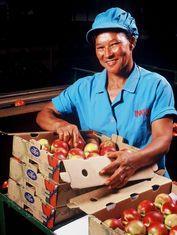
The figures speak for themselves as more new varieties ñ a high proportion of them bred in South Africa, as well as Californian types from elsewhere ñ are building up the Cape portfolio every year.
“Capespan plc is still a major world-wide player,” says Dunnett, who estimates that the marketing organisation handles more than 40 per cent of South Africa's peach, nectarine, apricot and plum crop, even since deregulation widened the choice for growers. “The next largest supplier is only in the region of 10-15 per cent,” he says.
“Our growers have become far more market orientated, and many have either visited the UK or met our customers in their own orchards, so they have a really good feel for the market, and are prepared to make the investment to keep ahead.”
This year the crop has been later than usual, but fruit flowed into the major retail outlets in time for Christmas.
APRICOTS
“We estimate that apricots, the first stone fruit to arrive, are about 10 per cent down although the season has been drastically compressed,” says Dunnett. “There was a combination of a warm winter and then a drop in temperatures which even saw snow in some regions.”
As a result Europe will receive some 120,000 cartons, of which a large proportion is always bound for the UK and mainly pre-Christmas.
These are mainly Super Gold and Imperial, but a new South African variety called Charisma will be making an appearance for the first time this year. Like much of South African stone fruit the initial pickings are airfreighted before the sea shipment programme gets underway.
PEACHES/NECTARINES
It has been a difficult winter for peaches and nectarines. Peach volumes have dropped, mainly due to inclement weather in the Transvaal, which provides a high proportion of the earliest fruit. San Pedro, Novadonna and Transvaalia peaches have been affected. Harvesting started a fortnight later than expected.
Nectarines in comparison are continuing to rise, despite the weather. Early volumes have been less affected, which is partly due to an increase in planting of the new early variety Alpine.
PLUMS
It is plums however where the main volume will come. South Africa has a four-million carton crop of which more than 1m cartons are expected in the UK by the end of the season.
“The UK has always been a strong and traditional market for plums, and this is still expanding,” says Dunnett.
Old varieties such as Santa Rosa, Harry Pickstone and Simka are being phased out, to be replaced by a range of proven new fruit including Ruby Red, Lady Red, Fortune and the pluot Flavorking. The season commenced with Pioneer in early December, followed by Sapphire, Souvenir, Ruby Nell, Laetitia and Larry Anne. Yellow varieties include Gaviota, the trademarked African Pride and Sungold. The latter part of the season is represented by Angeleno and Southern Belle.
The South African plum colour balance despite these changes has remained remarkably similar over the years, being around 15 per cent yellow, five per cent black and 80 per cent red.
There is likely to be a slight decline in overall stonefruit volume from South Africa this year, but that cannot mask a long-term growth trend. Apricot shipments to all sources have risen incredibly over a decade from 2,432 tonnes in 1993 to 5,643t in 2003. Peaches and nectarines show substantial growth from 6,000t to 9,570t in the same period, while plum production and export has also boomed. South African Customs figures show that the 20,000t shipped in 1993 had reached 36,377t 10 years on.
Dunnett has also seen other marketing changes. There was a time when Cape stonefruit was recognised by its intricate packaging. Wooden lidded crates that had to be opened with a “casing hammer” as it was known ñ something no respectable salesman on the wholesale markets would have been without. Inside fruit nestled for protection in wood wool, and at times was even wrapped.
“Today, this is a memory of the past,” he says. “More and more fruit is being presented at source in punnets or bags with close attention paid not only to the physical appearance but also the level of maturity so it is nearly ready to eat on arrival. Final pricing and catch weighing are carried out in the UK, but the time-saving and convenience factors have been speeded up enormously.”
Another element he believes has heightened consumer interest in the category is the development of the ready-to-eat concept by several major UK multiples.
“It is another example of the industry and consumer becoming more demanding,” he says, “and we have to respond. Really it is quite logical that the public wants to enjoy its purchase as soon as it has been made.”



